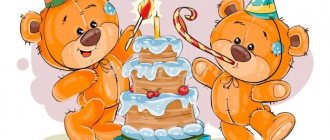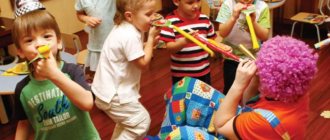Having fun with your kids is easy if you keep them busy. Outdoor games with competitions are what you need, especially in the summer outdoors and in the country. Ideal for entertaining children's birthday parties and other outdoor events.
Fun relay competitions force you to show strength and agility, patience and endurance. This is useful entertainment for children, helping to spend a couple of hours with excitement and fun. For team games, the more children the better, and the number of competing groups can be more than two, which is even more interesting. It is desirable that there be an equal number of participants in each team. And here is a selection of proven children's games and competitions for nature from Zavodila.com.
Game "Basketball Player"
A fun, energetic game for children who are dexterous and know how to keep time.
Props:
- basketball or any other medium size ball;
- gymnastic hoops, one for each participant.
Rules:
We lay out the hoops on the floor in a triangle if there are three participants, in a square if there are four, etc. Everyone stands behind their own. One of the players takes the ball and throws it into the hoop for the other. And he immediately moves his hoop back a step, moving away from the center.
The child into whose gymnastics circle the ball falls must catch it and throw it into someone else’s hoop. Then also move your circle one step away from the center.
This continues to throw between the participants (in a circle or in a chaotic order) until someone misses or catches the ball. This “loser” is eliminated from the game. We start again with the remaining children until there is only one participant left - the winner.
Fun indoor games for kids:
All parents try to tear their children away from mobile phones and lure them with fun outdoor games. Such activities are useful for the development of thinking, social adaptation and communication.
fun games for preschoolers
bowling game for children
Using tape, a bowling alley is created in the room. The labels are removed from the bottles and spray painted. The skittles are placed in a row at the end of the room or stacked in a pyramid. The children's task is to knock down the pins with a ball from a distance.
hit the glass game
Glasses are placed on a chair or table in front of the children. Each child is given 5 coins. Children take a few steps away from the target and try to throw a coin at their target. The player with the most coins wins.
hit the target game
The socks are rolled into small balls and tied. The bucket (target) is placed at a distance from the players. Participants take turns throwing socks into the bucket.
overcome game obstacles
follow the leader
puzzle games puzzles
Puzzles can be both fun and educational. Players need to assemble a picture from puzzles. For younger children, you can use 3D puzzle toys. Word puzzles improve vocabulary and are suitable for older children.
find matching pictures
Simple card games build logical thinking and encourage color and number identification. To play you will need sets of cards of various themes. Children can put cards in pairs, look for similarities, etc.
construction of a fort
The cardboard fort is made from boxes and secured with tape. The fortress is made from two pillows and a blanket. Sticks and blankets are used to form a wigwam tent.
domino effect game
Dominos are stacked high or placed on edge (parents can help). After all the elements are installed, the child turns over the first domino and watches as the remaining pieces repeat the example of the first one.
game find the toy
The toys are placed in a deep container and filled with clean water. The container is sent to the freezer and left there for several hours. The child is given salt or warm water in a bottle and asked to save the toy from the cold.
the most accurate arrows
Participants throw rings onto bright bottles from a certain distance.
treasure hunt game
Treats are hidden in different places. The participant is given the first clue, which leads to subsequent clues and eventually to the treasure itself.
potato game
Children sit in a circle and pass potatoes to each other to the music. Suddenly the melody is turned off and the child, who is holding the potato at that moment, leaves the game.
bubbles game for children
Place the dishwashing liquid in a plate, add a little water and stir until foam forms. The child dips one end of the straw into the foam and blows from the other end to create bubbles.
recognize an object by touch
A hole is cut in the box so that the child's hand fits inside. Then various objects are placed in it and the participant is asked to identify them by touch.
indoor games for schoolchildren
get caught in the web
Double-sided masking tape in the form of a web is glued to the doorway. Participants throw wads of paper or balloons at a target. The total number of points is calculated by the number of glued objects.
game chain of actions ball into glass
Participants must throw the ball to a partner, and he must catch it with his glass. They start close and then make things more difficult and take a step back.
action chain game
go through the maze
A labyrinth of obstacles is created in the corridor using crepe paper or tape. The tapes are fixed at different levels, forcing children to step or crawl at different points.
figure skating on floor
Space is being cleared on the floor for the “skating rink”. The player puts on a hat and mittens and imagines that he is gliding on the ice. For realism, put a pair of woolen mittens, boxes, or wet wipes on your feet.
bring the egg
Players take a spoon and any small round object that fits on top (egg, ball). Their task is to cover the distance without dropping the object from the spoon.
Guess the picture game
One player draws a motif, letter or word on the other's back with their finger. If your partner guesses the picture, they can draw next.
Creeping Monster
All players crawl on all fours, grabbing the ankles in front of the crawler. The monster moves very slowly throughout the apartment. The animal's head sets the direction.
Tangled Maze
A labyrinth is applied to the floor using masking tape. The player must find a way out. In the sports version, the participant can jump through the maze with a frog, and at the end make several long jumps.
There is a mouse game at home
Children holding hands. A mouse and a cat are running inside and outside the circle. Participants move in a circle with the words: “There is a mouse at home, she loves cheese, and outside the cat rushes at the mouse...” Meanwhile, the child playing the cat walks around the circle and tries to enter it, separating the children, who resist. If the “cat” manages to break the circle, he begins to chase the “mouse”. She runs away, and the children surround the “cat” and sing: “Run, run, mouse, the cat won’t catch you.” When the “cat” catches up with the “mouse”, the roles change.
catch a butterfly game
Each participant receives a long ribbon and a stick. The winner is the one who is the first to wind the thread around the stick and catch the butterfly.
fun games for teenagers: games with what's at hand
volleyball kicking game
Teenagers take off their shoes and form two teams. The volleyball net is hung at a height of at least 80 cm. Teams take their positions on both sides of the net. Participants play volleyball with their feet.
orange war
An orange is placed on the spoons of two players. Participants must knock over the opponent's fruit without touching it and at the same time try to hold on to their orange. The player who loses the citrus is eliminated. The winner fights with a new opponent until he is left alone.
Feed the fish
An equal amount of marshmallows is placed in two bags. Players are divided into pairs: fisherman and fish. Both partners stand at a distance of one and a half meters from each other. Players throw marshmallows into their partner's mouth. The couple that collects the maximum amount of marshmallows wins.
hit the target with the ball
Each player is given a balloon and asked to inflate it. Targets are placed on the floor at a distance of at least 150 cm. Participants must hit the target with the ball.
competition the most dexterous
The box is filled with cotton balls and sent to the table. Blindfolded players use a spoon to collect as many marbles as possible.
rules of the game scissors
The players sit in a circle. The presenter passes the scissors to the participant sitting to his left and says “crossed” or “not crossed.” The person who received the scissors repeats the same, passing them to the partner on the left. Crossed or uncrossed refers to the position of a player's legs when receiving and passing scissors.
Flying ball game
Players with their hand tied behind their backs try to keep a balloon in the air for as long as possible.
build a tower game
The tower can be built from books, boxes, blocks, etc. Teenagers are divided into teams, receive the necessary material and count down the time. The team that finishes first with the tallest tower wins.
game forfeits fun tasks
Before inflating the balloons, forfeits with tasks are placed in them. Players take turns popping the balls and completing the task that appears.
Pass the nut
Players sit in a circle with a plastic spoon in their mouth. Peanuts are placed on one of the participants' spoons and the game begins. The task is to pass the nut to the partner on the right. Whoever drops is out.
balloon fights
Two players each have a balloon tied to their foot. Their task is to destroy the opponent's ball while preserving their own.
stage props
Boxes with small props, such as spoons, decorations, socks, etc., are pre-prepared. Form teams and give each group a box. The participants’ task is to create and act out a short scene using props.
game tu
Participants of 2 teams stand behind each other. The first player is given a simple pencil, which he holds between his upper lip and nose. The task is to pass the pencil to the next player without using your hands with the phrase: “Tyu.” The fastest and most agile team wins.
Hold the pen
transfer it with your mouth
5 paper grocery bags are cut at different heights and lined up at the end of the room. Participants must move their bags to the opposite end. The trick is that they lift and move the bags only with their mouths.
Competition "Chicken Ryaba"
What is the Ryaba chicken from a children's fairy tale associated with - an egg. Let’s find the “clever hen” that lays eggs the fastest.
Props for each child:
- 20 plastic eggs or balls;
- 2 bowls large enough to hold the eggs;
- 1 plastic spoon.
Conditions : Place two bowls on the table in front of the participants - one empty and eggs in the other. Children clamp a spoon between their teeth and, at a signal, transfer eggs from one bowl to another using only a spoon, without using their hands. Those eggs that are dropped on the floor are considered “broken” and are not counted. Whoever manages it faster and lays the most eggs is considered the winner.
Celebration organization
For this wonderful holiday, parents need to prepare not only goodies for the table, but also an entertainment program for at least 2 hours. It should be lively and rich. Children should not be bored for a single minute. Not only the birthday boy, but every guest should feel like the “center of the universe.”
Therefore, parents of the birthday boy need to develop a plan for organizing and holding the birthday of a child of any age at home:
- determine the number of guests and give them colorful invitation cards
- create room decor (balloons, posters, garlands, etc.)
- buy a new outfit for the hero of the occasion
- buy a desired birthday gift for the birthday boy
- buy small gifts for all guests and gifts for prizes
- record popular and funny children's songs
- determine the holiday menu
- bake a fresh homemade cake and don’t forget about beautiful candles
- write a script for the holiday, including presenting gifts to the birthday boy, an invitation to the festive table, and consideration of gifts. Then entertainment events, songs, games, dances, competitions, riddles, etc.
Competition "Uncle Styopa"
This competition is for children with good balance who want to feel like they are on stilts. Only instead of stilts there will be wooden blocks on ropes.
Props for everyone:
- wooden bars 8*8*15 cm;
- jute or cotton rope 1 m long and 18 mm in diameter, choose a diameter (thickness) so that it does not cut into your palms.
Pre-drill through holes in the top of the block, and then insert the rope and secure with knots.
Conditions:
Each player takes a place at the start, stands with his feet on the bars, and takes the ropes in his hands. You must be the first to walk a given distance, walking on the bars. We help with our hands to regulate the rearrangement of the bars. The winner is the team whose children finish their races faster.
For teenagers, the competition conditions are more strict. At the choice of the leader, in case of touching the ground with a foot or any other part of the body:
- such a participant needs to return to the start and complete the distance again;
- or the child who stumbles drops out of the relay.
In the first option, the team that completes the relay faster wins. In the second option, the team will have the largest number of participants successfully complete the distance within a certain time (for example, three minutes).
Competitions “Chicken Ryaba” and “Uncle Styopa”
Board games for children 6 and 7 years old
Erudite
ozon.ru
- What develops: vocabulary, literacy, observation, logical thinking.
“Erudite” or “Slovodel” are Russian-language versions of the American game Scrabble, which is over 80 years old. The party involves from two to six people. And the one who scores the most points for composed words wins.
While playing with adults, younger schoolchildren not only learn new words, but also remember how they look in writing.
What to buy
- Board game “Scrabble”, 775 rubles →
- Board game Scrabble Junior from Mattel, 1,669 rubles →
Jenga
amazon.com
- What develops: spatial, architectural and figurative thinking, fine motor skills.
The game of Jenga, or "Leaning Tower", begins with the construction of this very tower from wooden blocks. And only then do the participants begin to walk: pull out one block from below and place it on top.
The winner's laurels go to the one who made the last successful move - before the collapse. The fun only seems simple: after all, before pulling out the next element, you need to imagine exactly how it is loaded, how the structure will behave. And movements must be as careful and precise as possible.
What to buy
- Board game “Panic in the Arctic” from the “Academy of Games”, 455 rubles →
- Board game “Jenga”, 1,149 rubles →
Jackal: Archipelago
leonardohobby.ru
- What develops: logical and systematic thinking.
The pirate strategy “Jackal” was created at Moscow State University in the 1970s and has not lost popularity since then. "Archipelago" is a new version of an old game, adapted for children. The rules have become clearer, the islands have become smaller, and the games have become shorter. But, most importantly, the mention of rum disappeared, which made it possible to recommend the board to children 6+.
What to buy
- Board game “Jackal: Archipelago”, 1,512 rubles →
Magic labyrinth
amazon.com
- What develops: spatial thinking, memory.
The highlight of the game is the double bottom. There is a labyrinth under the playing field, and a magnet ball is attached to each figure below. When a piece hits an invisible obstacle while moving, the magnet falls and the player must return to the starting point. It is important to remember the location of the maze walls and choose a safe path.
Considerations
au.ru
- What develops: reaction, vocabulary, communication skills, the gift of persuasion.
An advanced version of the word game. Participants have cards with letters and categories at their disposal. The topics can be very different: “You can find them in the country,” “Something oval,” or “You shouldn’t give them to children.” Let's say you pulled out the letter "M" and "Bites." Now all participants must remember who can bite and begin with “M”.
What to buy
- Board game “Consideration” from Hobby World, 478 rubles →
Game "Sniper"
A well-aimed hit is the main rule of this children's entertainment.
the props from the competition about Chicken Ryaba:
- 20 plastic eggs or small toys;
- 2 bowls large enough to fit the “shells”.
Conditions:
Seat a participant from each team 1.5-2 meters from the target - a bowl. It is necessary to throw all the toys there as quickly as possible. For each sniper, issue the same number of shells. Speed game. As soon as one of the children has thrown all of their toys into the basket (either hitting or missing), “Stop the game!” is announced. and count the eggs. Victory is given to the participant in whose bowl at that moment there will be more shells.
Accuracy game "Sniper"
Progress of the game:
This game can be played on the site or indoors. A treasure hunter is selected, he leaves and waits until he is called. The rest of the children hide some object in a separate corner of the area, call the treasure hunter and give him something like this: “You go straight, you reach a tree stump, you turn right from it, you reach a fence, then you turn left, you walk three steps straight and start looking, there is a treasure in that place.” The treasure hunter begins to search, and if necessary, the description of the route is repeated to him. When he finds the treasure, everyone congratulates him, a new treasure hunter is chosen and the game is repeated.
"The Frog and the Heron."
Material: chalk.
Competition "Siamese Twins"
This is a team competition where two people from a team compete at once.
The props you will need are a water stick (noodles) or a ball, and a balloon will also work.
Conditions:
We select two children from each group. Their task is to hold the aqua stick (ball or ball) between their foreheads, and in this position go the distance. The obligatory condition is to hold it so that it does not fall to the floor, and not to help yourself with your hands.
You can count during the competition: “one and, two and...”. This will set the rhythm and make it easier to complete the distance.
If teams have four, six or more children, the competition takes place in the form of a relay race, in which each pair runs its own segment.
For the birthday of a child 5-6 years old
I have already written about Answering “yes” to everything, not laughing, mummy, mirror and my other favorite games and competitions here. And today I have prepared some more fun activities.
"Basketball" is a game for a group of children.
Attach a wire ring to the wall at a height convenient for this age. The ball will be a balloon. The presenter explains to the children two rules of the game: the ball should not fall to the floor and it should not be held in their hands. The ball can be tossed and hit towards the ring. Whoever makes the most hits in the ring will receive a prize - a chocolate candy, the rest of the players will receive a caramel.
"Images".
Lay out cards with birds and animals depicted on them. The player approaches the table, takes a card and tries to portray with various movements and facial expressions the person who is drawn on it. The player who first guesses the image becomes the leader and the game continues.
“It's boring for us to sit” is a simple game for physical development.
Chairs are placed against the wall of the room for all children. There is one less chair placed against the opposite wall. Everyone sits down and reads the poem:
Oh, how boring it is for us to sit and look at the wall. Isn't it time to go for a run and change places?
At the leader’s command “start”, all players rush to the opposite wall and try to take a place. The one who is left without a chair is out of the game. Then another chair is removed. The game continues until the winner takes the last remaining chair. He is given a large ball (or something else), the rest of the players are given small balls.
Jenga is a board game that develops dexterity, fine motor skills and coordination.
This game is sold in a toy store. A tower of 18 levels is built from 54 multi-colored wooden blocks. To do this, the blocks are folded in threes and the resulting layers are laid on top of each other, one across the other. A cardboard guide will help you level the tower.
This game is best suited for 4 children. You can play with two or more players. They take turns throwing a die, each side of which has a color indicated on it. Now the player with only one hand needs to pull out a block of the same color from the tower and put it on top in order to continue construction. You cannot take blocks from the unfinished top layer and the layer below it. The player who destroyed the tower is considered the loser and the game continues.
"Nonsense" is a cool game.
Take a double (from the middle) notebook sheet of paper and two pens or two pencils. Two players sit at opposite ends of the table and draw, covering the drawing with their hand, someone’s head (a person, a dog, a hare, a cat, a goat). Then they bend the leaf so that the design is not visible, but only the neck is visible, and pass it to the second player. He draws the body (of a hare, a hedgehog, a person, a bear, a dog). He also folds the paper over to cover the drawing and passes it to the first player to draw someone's legs. Then he closes the drawing and passes it again to the second player, who draws someone’s feet. Now we unfold the drawing and see what happened? Funny and fun. Room decoration idea
6.Twine competition
After several active and active competitions, hold this one so that the “gymnasts” can prepare and stretch properly.
No props are required, only long legs of the participants and their stretching.
Conditions:
Teams with an equal number of people line up one after another at the start. The first athlete demonstrates stretching with a longitudinal or transverse split, choosing the one that is longer. The gymnast sits down and measures the distance with a split - then the second one stands and does his split from the mark of the first, the third participant does his split from the mark of the second, and so on. Those whose last player is further behind the line than the rest of their opponents from other teams will be the winners.
For cool photos, you don’t have to measure the length of each child’s twine, but take them all at the same time.
Online resources for children 6 and 7 years old
IQsha.ru
On the portal you can find selections of mathematical, logical and other educational games for preschoolers and first and second grade students. A 6-year-old child has a choice of 166 exciting activities that will help prepare for the upcoming studies. 158 educational programs for seven-year-old children are aimed at making the school curriculum easier.
Go to website →
Miracle Yudo
The largest online resource containing coloring books, puzzles, Sudoku, online crosswords and other intellectual fun for older kindergarteners and primary schoolchildren. Students of first and third grades can also take online tests here in the Russian language, mathematics and knowledge of the world around them.
Go to website →
Igrulez
The site provides a huge selection of educational games for children 6–7 years old. There are puzzles, rebuses, arithmetic problems, quests, and tests of attentiveness and logic.
Go to website →
Competition "Cunning Sweet Tooth"
The next competition is very tasty, lovers of sweets will be happy to volunteer. Moreover, it will be very appropriate at a children's birthday party.
Props for each participant:
- 1 pack of M&M's jelly beans;
- 1 plastic plate;
- 6 plastic cups.
Additional props: in a glass jar there are pieces of paper folded in four, on which the color of the dragee is written.
Conditions:
Each child is given props: a package of chocolate dragees, a plate and cups. The task is to pour multi-colored candies into a plate, and then sort them by color into each glass. There are six colors most commonly found in a bag of M&M's: brown, green, red, blue, yellow and orange.
After all the jelly beans are sorted by color, the player draws a piece of paper from the jar. By unfolding it, the child will find out what color of jelly bean he needs to eat. The one who eats the jelly bean of the chosen color the fastest wins and receives the title of the Artful Sweet Tooth.
Competition "Hockey Player"
Hockey is a sport for real men, according to the song. This will be a summer version for nature or a summer cottage.
Props for each participant:
- a hockey stick, you can make it yourself from a water stick or cut it from thin boards/plywood;
- a balloon or small ball;
- a gate made of wooden blocks or a plastic bucket, for example, from under construction materials.
Conditions:
One child from each team takes a place on the relay track with a stick and a “puck”. Their task is to go the distance faster than others, using a stick to push the ball, and then score it into the goal. Balloons are not "obedient" and it will take patience to push it to the target. The gates can be installed next to each other or, as in the real game, opposite each other. Then the children start from their own goal and kick the ball into someone else’s goal. The other participant also heads towards his opponent’s goal; when they meet, they can intercept the ball and hit it, thereby increasing the distance for the opponent to pass.
Another version of the competition is to score a small ball into the goal from a bucket that is placed on its side. Depending on the age of the children, you can change the conditions of the game: the first option is to bring the ball with a stick and score it into a bucket, and the other is to hit the ball with a stick from a distance of a couple of meters so that it flies into the bucket.
To make the competition more fun, cut out gorilla feet from isolon and put them on for the kids instead of skates. Make 2-3 times larger than the size of the children's feet and attach elastic bands or satin ribbons on top to secure them on the feet. These skates will not only allow you to run, but their funny appearance will ensure a fun game and cool photos.
Sedentary games indoors:
games with rules for preschool children
Bulb
Participants transfer the onion from one plate to another, holding it by the tail with their teeth.
Pyramid of barrels
Two players place kegs on top of each other. The participant whose barrel is the last and destroys the entire pyramid when it falls loses.
Catch the ray
At night, randomly turn off the light and move the beam from the flashlight around the room, including the ceiling, walls and floor. Children must try to catch the light.
Auto track
Using masking tape, you and your kids create a huge road system for toy cars. Players must drive their vehicles along it.
Team
4 participants hold the corners of the sheet or blanket on which the ball lies. Players try to throw it as high as possible and then catch it.
Strongmen
The participant takes off his shoes, lies on his back and raises his feet up. They place a ball on their feet and see how long they can hold it.
Sponge mat
The participant is given 16 multi-colored sponges and asked to fold a rug with a special pattern.
Hot lava
Paper is placed on the floor as “rocks” that you can walk on, the rest of the ground is a river of “hot lava” from the volcano. The goal of the game is to move the dinosaur “eggs” (rolled up socks) from one end of the room to the other by walking on the rocks. Any “accident” and a team member must start the race from the very beginning.
Fill the trays
Multi-colored caps from plastic bottles are distributed among the egg trays, following the color.
Nodes
Take a long rope and tie a knot in it approximately every meter. Each player must have their own node. For 6 participants – 6 knots. They give the rope to the children and ask them to stand in front of the knots. They must untie the knots without letting the rope fall to the floor.
Associations
On whatman paper, the contours of stones of different sizes and shapes are reproduced with a marker. The stones themselves lie in a basket in the center. The participant must place them in the correct place on the sheet.
Tennis
Participants play tennis with a hot air balloon and homemade rackets made from disposable plates and popsicle sticks.
Charade
Choose a topic, for example, sports, fairy tales, children's TV series, profession, etc. The child stands in front of the group and, without saying a word, presents a figure from the specified topic. The rest of the children must guess what the child is depicting.
Sumo wrestlers
Two team members' T-shirts and pants are stuffed with as many soft things as possible - pillows, stuffed animals and clothes - to transform them into real sumo wrestlers. At the signal, the fight begins. Whoever touches the floor first loses.
Jumping
The newspaper is cut into strips of 5 cm and laid out in the form of a ladder. The child's task is to jump up the steps.
games for primary school children
Nesmeyany
Players take turns naming a fruit or vegetable without showing their teeth. Repetition of fruits and vegetables is not allowed. Whoever shows his teeth or laughs is out.
Likes and dislikes
Participants make a list of five things they like and dislike. They then pass the lists to the presenter, who reads them out. Players must guess who the author of each list is.
Lemon
The competition requires two participants. The winner will be the one who eats the cut lemon without sugar the fastest. Depending on the age of the participants, you can use a whole lemon or parts of it.
Builders
2 teams are given a pack of straws and marshmallows. Their goal is to create a tall structure in a minute.
Funny mustache
Participants are given pencils that they hold between the base of their nose and their upper lip. The last one to hold it in place the longest will be the winner.
Forbidden letter
Each participant takes turns talking about their day, but first they choose a letter of the alphabet. Words starting with this letter cannot be used to describe the day.
Big ball
Each child is given a balloon that needs to be filled as much as possible with water without letting it burst. The player with the largest ball wins.
Count the peas
A bowl of peas is placed in the middle of the table. The players are seated around the bowl and given a cocktail straw and plate. The participant must fish the peas out of the bowl using a straw and transfer them to their plate.
Fill the bucket
Make holes in each inflated water balloon with a needle. Players must fill a bucket with leaking marbles. The first team to fill the bucket wins.
Water racing
One glass is filled with water, the other is empty. Each player has their own straw and must fill an empty glass with water by inhaling and pinching it. The team that completes the task first wins.
Cotton balls
Cotton balls are scattered on the floor, and there is an empty bowl in another room. In 3 minutes, the participant must use a spoon to collect all the balls into a bowl.
Visiting grandma
One participant starts with the sentence: “I'm going to grandma's and I'm taking with me...” and ends the sentence with an element that begins with the letter A. The next player repeats the sentence and ends the sentence with an element that begins with B. The competition continues with the rest of the alphabet.
Tie a knot
First in pairs and then alone, participants try to tie one or more knots on a rope with their feet.
Pillow race
The participant sits on an old pillow and moves as quickly as possible to the destination (for example, to the door at the end of the corridor). Players are allowed to push off with their hands and feet.
Mummy
Each team receives rolls of toilet paper and chooses a member to be mummified. After the start, each mummy needs to be properly wrapped, leaving only the eyes, mouth and nose open.
educational games for teenagers
Get the coin
Coins are placed in the feet of oversized tights. Players must reach each of the coins with one hand and place them on the chair.
Singers
The player puts some water in his mouth and tries to sing a song. The others guess its name. The one who guesses right will sing next.
Arrange the glasses
Two participants are given 3 glasses and a sheet of A4 paper. Players need to use a sheet to arrange the glasses on two floors, i.e. Place a third one on 2 separate glasses. The task is not easy, but there is a solution (see photo).
Darts
For the competition, balloons (target) are hung and points are assigned (20, 40, 60, 80 and 100 points). The winner is the participant who hits the target with the most points with the dart.
Fashionistas
Using 2 rolls of aluminum foil, ribbons, laces and elastic bands, girls must create the most creative outfit.
Get ready for a party
Six times as many socks are placed in the basket as there are participants. Players sit around the basket and, on command, try to put on as many socks as possible (on top of each other). When the music stops, the child with the most socks wins.
Hit the target
A glass jar is placed at the base of a stable chair. Players stand or kneel on a chair (facing the back of the chair) and try to throw clothespins into the jar. Everyone has five attempts.
string of pearls
Using long spaghetti (uncooked), players must thread 5 hollow spaghetti onto it without using their hands and earn points.
Football with towel
Players stand in pairs, holding a bath towel between them. They try to throw and catch the ball with a towel.
Collect items
Players must collect all the corks scattered on the floor into a wooden box, using only their toes.
Clothespins
Lifting a clothespin onto the edge of a cardboard box with your foot is a challenging competition that not only promotes spatial coordination, but also strengthens the muscles of the foot.
Sugar shot
Each player with a spoon in their mouth must place a pyramid of 6 sugar cubes on it. The first one to build a tower and hold it for 3 seconds wins.
Spoon frog
In this competition, participants are given 6 iron spoons. They must use one of the spoons to throw the others into a bowl or jar.
Builders
The participant is given 36 plastic cups. He must make a pyramid out of them in a minute, and then collect all the glasses in one pile.
Find the sweetness
Two plates are placed in front of the player. One contains candies hidden under a thick layer of whipped cream, and the other is empty. The participant must find the candies with his mouth and transfer them to an empty container.
Competition "Sorter"
This competition is less fluid but requires hand speed, concentration and dexterity.
The only props you will need are 250 ml paper cups in two colors, 20 pieces for each participant. Glasses of this size are easier to hold in your hand.
Conditions:
We give everyone 20 glasses: 19 pieces of one color - for example yellow, and one of another - green. Collect all the yellow glasses together, turn them upside down, and place the green glass on top. You need to move all the glasses one by one to the top glass so that the green one is on the bottom, while you need to constantly hold the glasses in your hands.
Whoever manages it first wins.
Warn that you need to move the cups STRICTLY ONE AT A TIME. In case of violation, the player is immediately eliminated. To make it easier to track kids who are trying to cheat, the cups can be numbered from 1 to 19. This way, if they appear inconsistently, the participant has cheated.
Puzzles and construction sets for children 6 and 7 years old
Tangram
amazon.com
- What develops: attention, abstract and spatial thinking, imagination, logic, ability to combine.
The essence of the classic puzzle, which was invented back in Ancient China, is to combine seven simple geometric shapes into a more complex image - the silhouette of an animal or person, a vehicle, a number, a letter, and so on. The options are virtually endless. For example, American programmer Doug Newfer managed to assemble Donald Trump from a tangram.
You can start with a house, a dog or a bird. The main thing is to use all seven elements, otherwise it doesn’t count.
What to buy
- Tangram from AliExpress, 56 rubles →
- Tangram from KriBly Boo, 196 rubles →
LEGO constructor
amazon.com
- What develops: fine motor skills, logic, lateral thinking, spatial imagination, perseverance, problem solving skills.
LEGO sets for ages 6+ contain hundreds of elements and several role-playing characters. The child is faced with the task of assembling a complex object from small parts, which requires attention, patience, perseverance and remarkable intellectual effort. As a reward, the young builder receives not only a beautiful design, but also confidence in himself and his abilities.
It is useful to build LEGO not alone, but with friends or parents. Firstly, it increases the chances of success. Secondly, it develops teamwork skills and communication abilities.
What to buy
- LEGO constructor “Mars Research Shuttle”, 1,629 rubles →
- LEGO constructor “Police station in the mountains”, 4,059 rubles →
- LEGO “Passenger Train” constructor, 8,549 rubles →
Labyrinth cube
amazon.com
- What develops: fine motor skills, logic, spatial imagination, coordination.
A classic transparent cube with a metal ball inside is an excellent opportunity to train not only your intellect, but also your hand-eye coordination, or, in other words, the “eye-hand” system (the eye sees, the hand performs). This skill is fundamental to successful learning to write.
What to buy
- Labyrinth cube from AliExpress, from 165 rubles →
- Maze ball Perplexus Rookie, 1,287 rubles →
Puzzles
amazon.com
- What they develop: fine motor skills, imaginative and logical thinking, correct perception of the connection between part and whole.
Children aged 6 years and older can sort elements by color, shape or part of a picture. They can be offered quite complex puzzles with 100+ small pieces.
What to buy
- Puzzle “Thomas and his friends” from Step Puzzle, 100 rubles →
- Puzzle “London” from Dodo, 258 rubles →
- Coloring puzzle “Dinosaurs” from Bradex, 732 rubles →
Rubik's Snake
amazon.com
- What develops: spatial and logical thinking, imagination.
The best-selling game of the 1980s remains a hit among mechanical puzzles. In terms of complexity, it is inferior to the Rubik's cube. And besides, you can get more than 100 figures from a snake, which gives room for imagination. Therefore, success is guaranteed for older kindergarteners and first-graders.
What to buy
- Rubik's snake from AliExpress, from 40 rubles →
- Big Rubik's Snake, 969 rubles →
Quadrillion
amazon.com
- What develops: logical thinking, imagination, perseverance, attentiveness.
The puzzle includes 12 pieces of different colors and shapes and four black and white magnetic grids that fold into the playing field. You need to fill it, using all the parts and not leaving a single empty recess.
Since magnetic grids can be connected in various ways, the number of tasks reaches 80. And the level of difficulty ranges from “couldn’t be easier” to “almost impossible” (answers for this case are provided at the end of the book with tasks).
What to buy
- Logic game “Quadrillion” from Bondibon, 1,403 rubles →
Cat and Mouse Competition
Catch-up is a game in which one person catches and the other runs away. Everything is simple when you run fast and your eyes are open. There is a little catch in this fun competition outdoors or at home.
Props for each team:
- blindfold;
- fencing tape;
- one ball for the competition.
Conditions:
Each team requires two participants. The first team is “mouse”, and the second is “cat”. We blindfold one mouse and one cat. Using tape, rope or chalk, make a circle 3-5 meters in diameter. Wearing bandages, we bring the cat and the mouse to the edge of the circle, placing them diagonally opposite each other. We put the ball, it’s cheese...
The mouse’s task is to find the cheese, and the cat’s task is to catch the mouse before it grabs the “delicacy.” Place the cheese ball anywhere in the circle, but after the children are blindfolded. Next, the mouse tells the mouse, and the cat tells the cat where to go: left, right, back and forward. Whoever completes his mission the fastest wins. Leaving the circle is not considered a defeat.
Competitions for children's birthdays
cartoon heroes
The presenter voices various characters (names) from famous cartoons, and the children must quickly remember and say the full name of this cartoon. For example, Vintik, Shpulya ("Fixies"), Uncle Fyodor, cat Matroskin, ("Three from Prostokvashino"), Gecko, Alet ("PJ Masks"), Losyash ("Smeshariki"), Caramelka ("Three Cats") .
You can divide the players into teams or each for themselves (depending on the number of participants). For the correct answer (who is faster) give a token. The one with the most wins.
Favorite color
Each participant chooses a marker of their favorite color and receives a sheet of paper. On command (or turn on the music track), players must draw on their sheet such objects that have the selected color of the felt-tip pen. For example, if it is yellow, then you can draw the sun, lemon, boots, book, etc. Whoever draws the most objects in 2-3 minutes wins.
Try again
Stick it on the wall (or put a blank sheet of paper on the table). Place the participant in front of this sheet. Tape the second sheet of paper onto the back of this participant. Another person draws on his back (on a glued sheet) some kind of intended picture, for example, a house, but not all at once, but in parts (roof, square, window, door), and the one on whom they draw must try to repeat everything on on your sheet. The one (couple, team) who has the most similarities wins.
Wrap it up
Tie a long rope, for example, a straw for drinks, on one side, and an object, for example, a car or a soft toy, on the other. Make such sets according to the number of teams. Whoever wraps the entire rope around the tube the fastest wins.
One two Three…
Children stand in a circle. Some kind of prize is placed in the center. The presenter begins to count: “One, two, thirty...twenty.” "One, two, three...eleven." “One, two, three...twenty-three.” “One, two, three...step.” The participants’ task is to grab the prize on the count of “one, two, three.” Whoever reacts first gets a reward.
Here you can divide the players into pairs and play this game several times.
Tubes and papers
Cut several sheets of paper of different colors (for example, red, blue, yellow) into small squares according to the number of participants. Give each participant a cocktail straw. The task is to use a straw to suck up only your own color of paper (each player chooses their own color) and fold it in front of them (can be in any container). The winner was the one who managed to collect the most pieces of paper without errors in the set time (2-3 minutes).
As an option: on one of the squares (of each color) make some kind of mark, for example, an asterisk and turn it over with the pattern down. Whoever finds this star faster (using the above method) will receive an additional prize or be the winner of the game.
You can also organize one big game - a quest for all participants at once with a search for treasure. Children can participate in one small group (up to 10 people), or divide them into two teams. The quest can be organized both indoors and outdoors. Check out our selection of fun search quest scenarios. Fun, excitement and good mood will be guaranteed.











